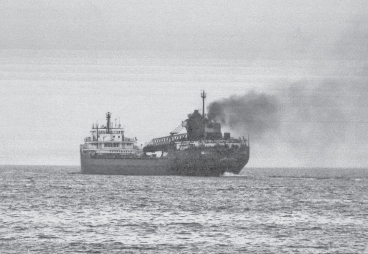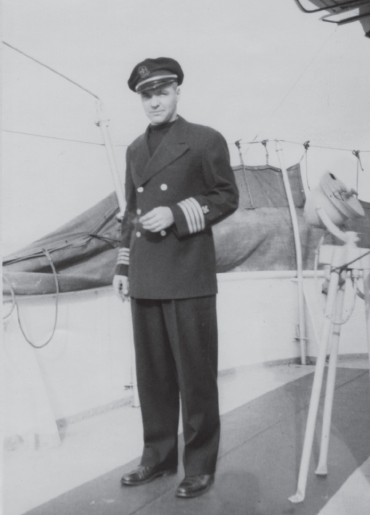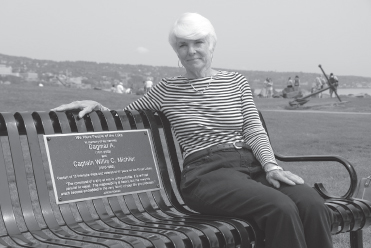Ship Captain's Daughter (10 page)
Read Ship Captain's Daughter Online
Authors: Ann Michler Lewis
It was in the spring, just after the ice broke up, that my dad died. After his funeral in Duluth, my mother, my husband, the children, and I decided to go down to Canal Park. Just as we were unbuckling our seat belts, we heard the loudspeaker from the Marine Museum Visitor Center announce that the 694-foot-long SS
Herbert C. Jackson
was departing the harbor bound for Chicago with twenty-two thousand tons of taconite pellets. This had been Dad's last command! I shouted to everyone to run for the pier.
We dodged through the parking lot as fast as we could, but by the time we pushed through the crowd around the popcorn wagon, with a half block still to go, the ship had already gone under the Aerial Bridge, and its after-cabin, with its big black stack and orange band, was gliding by.
We tried to catch up to it, to run alongside it, but it kept slipping farther ahead of us. Finally, we had to give up. Panting, we stopped and watched it clear the lighthouse at the end of the breakwater, and then we saw the flag on the stern begin to flap in the off-shore breeze.
The others got cold and began to walk back. But Mom and I stayed.
I envisioned a handsome young captain stepping away from the pilothouse window, saying, “I'm going downstairs now, boys,” then, “Keep her steady as she goes, Charlie,” and “It's all yours
now,” to the mate. Soon the ship looked like a little toy, then like a brown dot, then just a smudge on the horizon.

The SS
Herbert C. Jackson
, Dad's last command, leaves the Twin Ports of Duluth-Superior for yet another trip “down below.”
DIANE HILDEN
“Goodbye, Willie,” I heard Mother whisper. We stood there watching until the ship melted into a cloud, and then it was gone, due at the Soo in twenty-six hours, and thirty-six hours later at a steel mill in Chicago, where another ship captain's wife and daughter would be waiting for it, down below.

The experience of command of a ship at sea is unforgettable; it is without parallel or equal. The responsibility is heavy, but the rewardsâwhich become embedded in the very fabric of your lifeâare priceless.
F
ROM
C
OMMAND AT
S
EA
My thanks to Kate Thompson, senior editor at the Wisconsin Historical Society Press, for her vision of memoir as history and her interest in mine.
Thanks also to developmental editors Sara Phillips for drawing out my father's Wisconsin heritage and Erika Wittekind for honing the work and teasing out additional dimensions, as well as Elizabeth Boone for seeing it through production.
John Toren was coauthor in many instances. His sensitivity, language skill, and mechanical expertise helped nudge the story to what it wanted to be, and his idea of bringing it to the Wisconsin Historical Society is the reason the book in this form exists.
The list of further acknowledgments is daunting.
I thank my parents, who saved pictures and articles and who wrote journals with a sense that this life mattered. Childhood friends Ann Jenkins and Jeffrey Long shared my experience of growing up in a maritime community on a lake with an alluring and relentless horizon and thought I should share this regional life. My husband, Herb, and children, Amy and Lee, contributed through suggestions from their own memories. Louis Jenkins read, commented, and encouraged, as did Marit Nowlin, Peggy Dollinger, Professor Catherine Guisan, Bill and Linda Lundberg, Laura and Peter Merriam, Jan and Bill Munson, Linda Smith, Anita Zager, Fred and Jan Martin, Mara Hart, and Judith Josephson.
Local people connected to the shipping industry were essential in providing the correct facts and vocabulary. Davis Helberg, former director of the Seaway Port Authority, graciously arranged
for me to attend a Propeller Club meeting, where I met mariner icons Dick Bibby, Wes Harkins, and Captain Gil Porter, who knew my father. Captain Porter volunteered his ongoing help and sat with me in his kitchen going through the manuscript word by word to make sure it was “right.” Great Lakes pilot Shawn Mckenzie also met with me early on, made suggestions, and connected me with Ellen Leu, whose father was the storyteller in “Winter Life” and with whom I had a delightful exchange regarding our experiences as ship captain's daughters. Brian Thierry told me about loading. Mary George from the Lake Superior Maritime Visitor Center was an ongoing source of valuable information. She told me about the weight of ice on ships and also sent me to
Lake Superior Magazine
editor Konnie LeMay, who looked at the collection of material and asked the critical question, “What's the story?”
Archivist Laura Jacobs from the Jim Dan Hill Library at the University of Wisconsin-Superior supplied important data and found the picture of my father's first command.
Editors went through it in evolving stages: Julie Jensen, Gail Trowbridge, Jill Breckenridge, Evelyn Klein, and Connie Wanek, all with critical input, and professors Calvin Roetzel, Paula Cooey, and Jean Jacobson were cheerleaders.
Jeff Shroeder got me untangled from many computer panics, and Amy Jenkins was the very first person who combined the initial vignettes and laid them out in a way that suggested they might become a book.
J'ai Lisa's interest at Kinko's was heartening.
Finally, my sincere thanks to those I may have forgotten but whose ideas, information, and affirmation have made an invaluable contribution to the final product.

MARY T. GEORGE
Ann Michler Lewis grew up in Duluth, Minnesota, where she lived from 1944 to 1967. She graduated from the University of Minnesota, Duluth, and taught English at Duluth East High School. Since 1972 she has lived in St. Paul, Minnesota, where she and her husband raised their son and daughter, making periodic family pilgrimages back “home” to Lake Superior. She has privately published a book of poems and sailing stories called
My Duluth
, now out of print. Fascinated by how the power of place shapes the human story, she thinks British writer Lawrence Durrell has captured it best: “We are the children of our landscape. It influences behavior and even thought, in the measure to which we are responsive to it.”